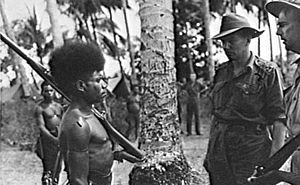Australian New Guinea Administrative Unit facts for kids

The Australian New Guinea Administrative Unit (ANGAU) was a special group created by the Australian Army during World War II. It was set up on March 21, 1942. Its main job was to manage the areas of Territory of Papua and the Mandated Territory of New Guinea.
Before ANGAU, these areas had a regular government. But during the war, the army took over. ANGAU became the new government from February 1942 until the war ended.
Contents
What was ANGAU?
ANGAU stands for the Australian New Guinea Administrative Unit. It was a military group that acted like a government. Its main base was in Port Moresby.
ANGAU's Important Jobs
ANGAU had many important tasks during the war. These jobs helped the war effort and the local people.
Keeping Order and Health
ANGAU officers worked to keep law and order. They also provided medical services. They focused on areas that were not taken over by the Imperial Japanese forces. ANGAU reported to the New Guinea Force, which was the main army group in the region.
Supporting the War Effort
A big part of ANGAU's work was to organize resources. This included land and people to help with the war. They made sure that the Australian and American armed forces had the help they needed.
Helping Local People
ANGAU was also in charge of recruiting local workers. They organized and supervised these workers. These local people helped the soldiers in many ways. ANGAU also helped local people in areas that the Allies had taken back from the Japanese. They helped them rebuild their lives.
Managing Soldiers
ANGAU was also responsible for managing the Pacific Islands Regiment. This was a group of soldiers from the Pacific Islands who fought alongside the Australian and American forces.
How ANGAU was Seen
The ANGAU officers were highly respected. So were the New Guinean carriers, laborers, scouts, guides, and police. The American and Australian military valued their hard work and bravery.
The End of ANGAU
After World War II ended, ANGAU was no longer needed. It was officially closed down. A new combined government took its place. This new government managed both Papua and Australian New Guinea.

